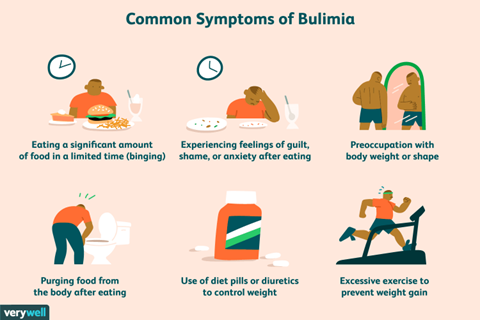A nurse is contributing to the plan of care for a client who has bulimia nervosa. Which of the following interventions should the nurse recommend?
Administer bupropion 1 hr before meals
Allow the client access to food throughout the day
Weigh the client once weekly
Observe the client for 1 hr after meals.
The Correct Answer is D
d. Observe the client for 1 hr after meals.
Explanation:
The correct answer is d. Observe the client for 1 hr after meals.
For a client with bulimia nervosa, it is important to closely monitor their behavior after meals to prevent purging behaviors and ensure their safety. Observing the client for 1 hour after meals allows the nurse to provide support, encourage healthy coping strategies, and intervene if necessary to prevent purging episodes.
Option a, administering bupropion 1 hour before meals, is not an appropriate intervention for bulimia nervosa. Bupropion is an antidepressant medication that may be used for certain mood disorders, but it is not the primary treatment for bulimia nervosa.
Option b, allowing the client access to food throughout the day, is not a recommended intervention for a client with bulimia nervosa. Clients with bulimia nervosa often struggle with impulse control and binge eating behaviors. Allowing unrestricted access to food may exacerbate their symptoms and increase the risk of binge-purge cycles.
Option c, weighing the client once weekly, is not the most appropriate intervention for managing bulimia nervosa. While weight monitoring may be a component of treatment, it should not be the sole focus. The treatment for bulimia nervosa involves addressing the underlying psychological and behavioral factors contributing to the disorder.
By recommending the observation of the client for 1 hour after meals, the nurse can provide necessary support, monitor the client for potential purging behaviors, and promote a safe and therapeutic environment for their recovery from bulimia nervosa.

Nursing Test Bank
Naxlex Comprehensive Predictor Exams
Related Questions
Correct Answer is A
Explanation
Answer: A. Pull the auricle upward and outward.
Rationale:
A. Pull the auricle upward and outward:
Pulling the auricle upward and outward is the recommended technique for instilling ear drops in an adult. This method straightens the ear canal, allowing better access for the medication to reach the target area. It is essential for effective delivery and absorption of the otic suspension.
B. Pull the auricle downward and backward:
Pulling the auricle downward and backward is appropriate for children under three years old, as it aligns their shorter and straighter ear canal. In adults, this approach would not straighten the canal sufficiently for optimal medication instillation.
C. Pull the auricle upward and backward:
While pulling the auricle upward and backward can straighten the adult ear canal, the optimal direction to ensure the ear canal is fully open is upward and outward. This position allows the medication to reach deeper parts of the ear canal effectively.
D. Pull the auricle downward and outward:
Pulling the auricle downward and outward is not suitable for adults and does not provide the correct alignment for an adult ear canal. This technique is ineffective in reaching the canal's deeper parts in adult clients, thus limiting the efficacy of the medication.
Correct Answer is B
Explanation
Answer: B. Stiff posture
Rationale:
A. Lip-smacking : Lip-smacking is not typically an indication of pain in newborns. It may be associated with hunger or neurological responses, but it does not directly indicate discomfort or pain caused by shoulder dystocia or other injuries.
B. Stiff posture : A stiff posture can indicate pain in newborns, as they often exhibit hypertonicity or rigidity when experiencing discomfort. This response is a protective mechanism and may suggest the newborn is reacting to pain from potential nerve or tissue damage caused by shoulder dystocia.
C. Weak cry : While a weak cry may indicate neurological or respiratory distress, it is not a specific sign of pain. In the context of shoulder dystocia, a weak cry could reflect complications such as brachial plexus injury but does not directly signify the presence of pain.
D. Tongue-darting : Tongue-darting is more commonly associated with neurological issues or feeding difficulties rather than pain. It is not a typical behavioral response to discomfort or injury in newborns experiencing complications like shoulder dystocia.
Whether you are a student looking to ace your exams or a practicing nurse seeking to enhance your expertise , our nursing education contents will empower you with the confidence and competence to make a difference in the lives of patients and become a respected leader in the healthcare field.
Visit Naxlex, invest in your future and unlock endless possibilities with our unparalleled nursing education contents today
Report Wrong Answer on the Current Question
Do you disagree with the answer? If yes, what is your expected answer? Explain.
Kindly be descriptive with the issue you are facing.
